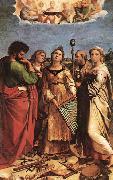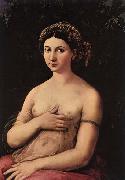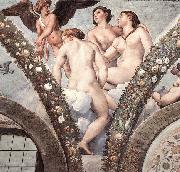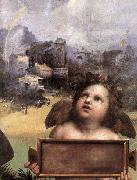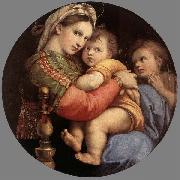
|
Artists
Index
|
||
|
RAFFAELLO Sanzio
|
||
|
St Cecilia new21/RAFFAELLO Sanzio-355679.jpg Pintura identificación:: 63785 |
220 x 136 cm Pinacoteca Nazionale, Bologna Raphael probably accompanied Leo X when he went to Bologna to meet the King of France, Francis I, in 1515. He may have passed through Florence, where Leo was welcomed with great enthusiasm by his fellow citizens. Leonardo da Vinci - who later accepted the French King's invitation to Paris - and Michelangelo - to whom Leo X commissioned the New Sacristy of San Lorenzo - also followed the Pope. A letter which Raphael sent to the painter, Francesco Francia, provides proof of this journey. According to a legend, Francesco Francia died after seeing the St Cecilia which Raphael painted for the Church of San Giovanni in Monte in Bologna. The story is almost credible, for the Bolognese artistic environment still revolved around the style of Perugino. The painting was commissioned by Elena Duglioli dall'Olio of Bologna. She was famous for having visions and ecstatic fits in which music played a great part, which is probably why she asked for a picture of St Cecilia, the patron saint of music. Raphael decided on a painting in the style of a Sacra Conversazione, with St Cecilia in the centre surrounded by saints. The altarpiece, which is now in the Museum of Bologna, was placed in San Giovanni in Monte in 1515. It was painted some time before, however. The glorification of purity is the central idea behind this painting. This is expressed by the figures seen on both sides of the principal figure: St John the Evangelist is the patron saint of the church, and St Paul symbolizes innocence, while St Augustine and St Mary Magdalene stand for purity regained through atonement after sinful aberration. The four saints who surround the protagonist form a niche which is strengthened by the poses and gestures of the figures (the glances of the Evangelist and St Augustine cross, St Paul's is lowered and the Magdalene turns hers toward the spectator). Only St Cecilia raises her face toward the sky, where a chorus of angels appears through a hole in the clouds. The monumentality of the figures, typical of Raphael's activity during this period, dominates the other figurative elements. In the legend of St Cecilia, too, the painter emphasizes her desire to preserve her purity. As they were escorting Cecilia to the house of her betrothed, to the accompaniment of musical instruments, in her heart she called out only to God, beseeching Him to preserve the chastity of her heart and her body. So runs the fifth-century legend, and accordingly in this picture Cecilia does not hear the profane music, her eyes raised toward the heavens connects her directly with the choir of angels. This much is in complete agreement with the story of the Roman martyr.Artist:RAFFAELLO Sanzio Title: St Cecilia Painted in 1501-1550 , Italian - - painting : religious | |
| |
|
|
|
|
||
|
Portrait of a Young Woman new21/RAFFAELLO Sanzio-673858.jpg Pintura identificación:: 63786 |
1518-19 Oil on wood, 85 x 60 cm Galleria Nazionale d'Arte Antica, Rome Much of Raphael's energy during his last years was directed toward public activity, or at least toward commissioners who were influential in city life and life within the Papal States (he designed a villa, known as the Villa Madama, for Cardinal Giulio de' Medici). Furthermore, many critics attribute to him a series of compositions of the Holy Family and of Saints which were then executed by his followers. The famous portrait of a young woman, called La Fornarina, must also be viewed in this perspective, although it is signed, in Latin, "Raphael from Urbino". The signature is engraved on the thin ribbon that the girl wears just under her left shoulder. Tradition identifies her with Margherita Luti, a Sienese woman whom Raphael loved, the daughter of a baker from the Roman district of Santa Dorotea. The stiffness of her features and the heavy chiaroscuro effect make La Fornarina an almost certain workshop piece with the contribution of Raphael, for Raphael's own work from this period is far more delicate. There are several old copies of this painting, the most famous in the Galleria Borghese.Artist:RAFFAELLO Sanzio Title: Portrait of a Young Woman (La Fornarina) Painted in 1501-1550 , Italian - - painting : portrait | |
| |
|
|
|
|
||
|
Cupid and the Three Graces new21/RAFFAELLO Sanzio-537552.jpg Pintura identificación:: 63787 |
1517 Fresco Villa Farnesina, Rome It was said that only in the presence of the Three Graces could a young man recognize the charms of his beloved. Cupid is looking at the Graces and pointing with his left hand, not at Psyche, but at the loggia itself, the Chigis own world. This is no doubt meant to refer to the lady of the house. Pope Leo X liked Giovanni da Udine's garlands so much that he commissioned the painter to decorate the first floor of the loggia in the Vatican with similar floral motifs.Artist:RAFFAELLO Sanzio Title: Cupid and the Three Graces Painted in 1501-1550 , Italian - - painting : mythological | |
| |
|
|
|
|
||
|
The Madonna of Foligno new21/RAFFAELLO Sanzio-543756.jpg Pintura identificación:: 63788 |
1511-12 Oil on canvas Pinacoteca, Vatican The papal secretary Sigismondo de'Conti donated this ex voto altarpiece in 1511. A meteorite had fallen on Conti's house, a catastrophe Conti himself survived. Raphael portrays this event in the background.Artist:RAFFAELLO Sanzio Title: The Madonna of Foligno (detail) Painted in 1501-1550 , Italian - - painting : religious | |
| |
|
|
|
|
||
|
Madonna della Seggiola new21/RAFFAELLO Sanzio-434935.jpg Pintura identificación:: 63789 |
1514 Oil on wood, diameter 71 cm Galleria Palatina (Palazzo Pitti), Florence Raphael painted the picture in Rome, probably during the period immediately after the completion of the Stanza di Eliodoro. It soon passed into the Medicean collections. It was already there by 1589 and has been in the Pitti since the 18th century. It was carried off to Paris by the Napoleonic troops in 1799 and brought back to Florence in 1815. A celebrated picture in which Raphael is under the influence of the antique and of the Venetian school, of Titian and of Sebastiano del Piombo. The form of a "tondo" is in itself a reminder of Florence and carries us back to the taste of the Quattrocento. Of the form of the tondo the artist preserves and emphasizes the curve with his genial adaptation of the figures to the outline of the painting. And yet the composition is in no way forced, but on the other hand the figures in following the curve become more closely entwined together. This grouping, this closing around the fulcrum of the tondo coincides with the centre of affection - the little Christ, the spiritual centre of the picture. The colour, in spite of its vividness, has a fusion and a warmth which Raphael attains with genial and personal mastery.Artist:RAFFAELLO Sanzio Title: Madonna della Seggiola (Sedia) Painted in 1501-1550 , Italian - - painting : religious | |
| |
|
|
|
|
||
| Previo Artista | ||
|
Also Buy::. For Following Paintings / Artists / Products, Please Use Our Search Online: |





